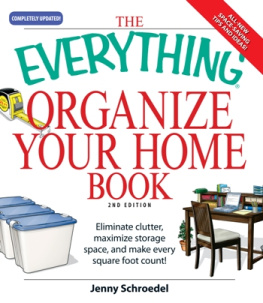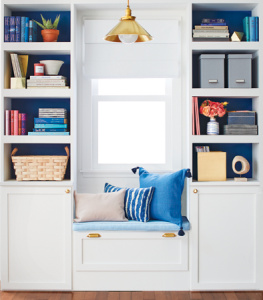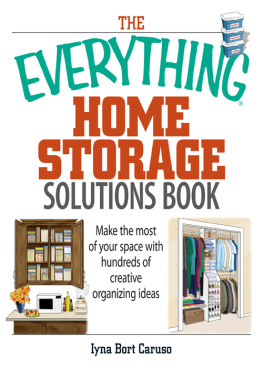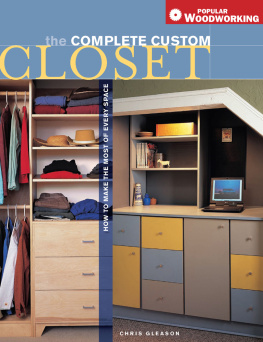Editorial and Production Team
Vern Johnson, Peggy McDermott, Rick Muscoplat, Mary Schwender, Marcia Roepke
Photography and Illustrations
Ron Chamberlain, Tom Fenenga, Bruce Kieffer, Mike Krivit, Don Mannes, Ramon Moreno, Shawn Nielsen, Doug Oudekerk, Frank Rohrbach III, Eugene Thompson, Bill Zuehlke
Text, photography and illustrations for Ultimate Organizing Solutions are based on articles previously published in The Family Handyman magazine (2915 Commers Dr., Suite 700, Eagan, MN 55121, familyhandyman.com). For information on advertising in The Family Handyman magazine, call (646) 293-6150.
Ultimate Organizing Solutions is published by The Readers Digest Association, Inc. 2015 The Readers Digest Association, Inc. All rights reserved. This volume may not be reproduced in whole or in part without written permission from the Publisher. Readers Digest and the Pegasus logo are registered trademarks of The Readers Digest Association, Inc. The Family Handyman is a registered trademark of RD Publications, Inc.
ISBN: 978-1-62145-240-9
eISBN 978-1-62145-262-1
THE FAMILY HANDYMAN
Editor in Chief Ken Collier
Project Editor Eric Smith
Design & Layout Diana Boger, Teresa Marrone, Bruce Bohnenstingl
Senior Editors Travis Larson, Gary Wentz
Associate Editor Jeff Gorton
Administrative Manager Alice Garrett
Senior Copy Editor Donna Bierbach
VP, Group Publisher Russell S. Ellis
Published by Home Service Publications, Inc.,
a subsidiary of The Readers Digest Association, Inc.
A NOTE TO OUR READERS: All do-it-yourself activities involve a degree of risk. Skills, materials, tools and site conditions vary widely. Although the editors have made every effort to ensure accuracy, the reader remains responsible for the selection and use of tools, materials and methods. Always obey local codes and laws, follow manufacturer instructions and observe safety precautions.
Contents
CHAPTER
CHAPTER
CHAPTER
CHAPTER
CHAPTER
CHAPTER
CHAPTER
CHAPTER
Kitchen & bathroom


Kitchen cabinet rollouts

WHAT IT TAKES
Time: 4 hours
Skill level: Intermediate
B ase cabinets have the least convenient storage space in the entire kitchen. Rollouts solve that problem. They make organizing and accessing your cabinet contents back-friendly and frustration-free.
If youre stuck with cabinets without rollouts, dont despair. Here youll learn how to retrofit nearly any base cabinet with rollouts thatll work as well as or better than any factory-built units.
Its really very easy. Once you take measurements, you can build the rollout drawer (15).
The project will go faster if you have a table saw and miter saw to cut out all the pieces. A circular saw and cutting guide will work too; itll just take a little longer. You can build a pair of rollouts in a Saturday morning.
What wood products to buy
These rollout drawers are made entirely of 1/2-in. Baltic birch plywood. Baltic birch is favored by cabinetmakers because its void free, meaning that the thin veneers of the plywood core are solid wood. Therefore sanded edges will look smooth and attractive. If your local home center doesnt stock Baltic birch, find it at any hardwood specialty store.
If you choose, you can make the sides of the rollout drawers from any 1x4 solid wood that matches your cabinets and then finish to match (use plywood for the bases). But if you use 3/4-in. material for the sides, subtract 3 in. from the opening to size the rollout (not 2-1/2 in., as described in ).
The drawer carriers (). The MDF keeps the drawer bottom spaced properly while you shim and attach it to the cabinet sides. It can be removed and reused for other carriers after installation. If MDF isnt available, substitute any other 1/4-in. hardboard or plywood.
Side-mounted slides are the best choice among drawer slide options. Their ball-bearing mechanisms and precise fit make for smooth-operating drawers that hold 90 lbs. or more. Shown here are 22-in. full-extension side-mount drawer slides that have a 90-lb. weight rating. That means theyll be sturdy enough even for a drawer full of canned goods. Full-extension slides allow the rollout to extend completely past the cabinet front so you can access all the contents. You can find slides at any home center or well-stocked hardware store.
Measure carefully before you build
Nearly all standard base cabinets are 23-1/4 in. deep from the inside of the face frame ().
Then measure the cabinet width. The drawer has to clear the narrowest part of the opening ().
Shown here are drawers with 3-1/2-in.-high sides, but you can customize your own. Plan on higher sides for lightweight plastic storage containers or other tall or tippy items, and lower sides for stable, heavier items like small appliances.
Drawer slides arent as confusing as they may seem
At first glance, drawer slides are pretty hard to figure out, but after you install one set, youll be an expert. Theyre sold in pairs and each of the pairs has two parts. The drawer part attaches to the rollout while the cabinet part attaches to the carrier. To separate them for mounting, slide them out to full length and then push, pull or depress a plastic release to separate the two parts. The cabinet part, which always encloses the drawer part, is the larger of the two, and the mounting screw hole locations will be shown in the directions. (Screws are included with the drawer slides.) The oversized holes allow for some adjustment, but if you follow the instructions, you shouldnt have to fuss with fine-tuning later. When mounting the slides, you should make sure to hold them flush with the front of the rollout drawer and carrier sides (). The front of the drawer part usually has a bent metal stop that faces the front of the drawer.
Assembling parts and finishing the rollouts
Its important to build the rollout drawers perfectly square for them to operate properly. show a simple squaring jig that you can clamp to a corner of any workbench to help. Use the jig to nail the frame together, but even more important, to hold the frame square when you nail on the bottom panel. If it hangs over the sides even a little, the drawer slides wont work smoothly.
Use 1-1/4-in. brads for all of the assembly. Glue the drawer parts together but not the bottom of the carrier. It only serves as a temporary spacer for mounting. (After mounting the carrier and drawer, you can remove it if it catches items on underlying drawers or even reuse it for other carriers.) If youd like to finish the rollout for a richer look and easier cleaning, sand the edges with 120-grit paper and apply a couple of coats of water-based polyurethane before mounting the slides.
To figure the spacer thickness, rest the lower carrier on the bottom of the shelf, push it against one side of the cabinet and measure the gap on the other ().
Slip the rollout into its carrier and check for smooth operation. If you followed the process, it should work perfectly. If it binds, its probably because the spacers are too wide or narrow. Pull out the carrier, remove the spacers and start the spacer process all over again.
Next page










